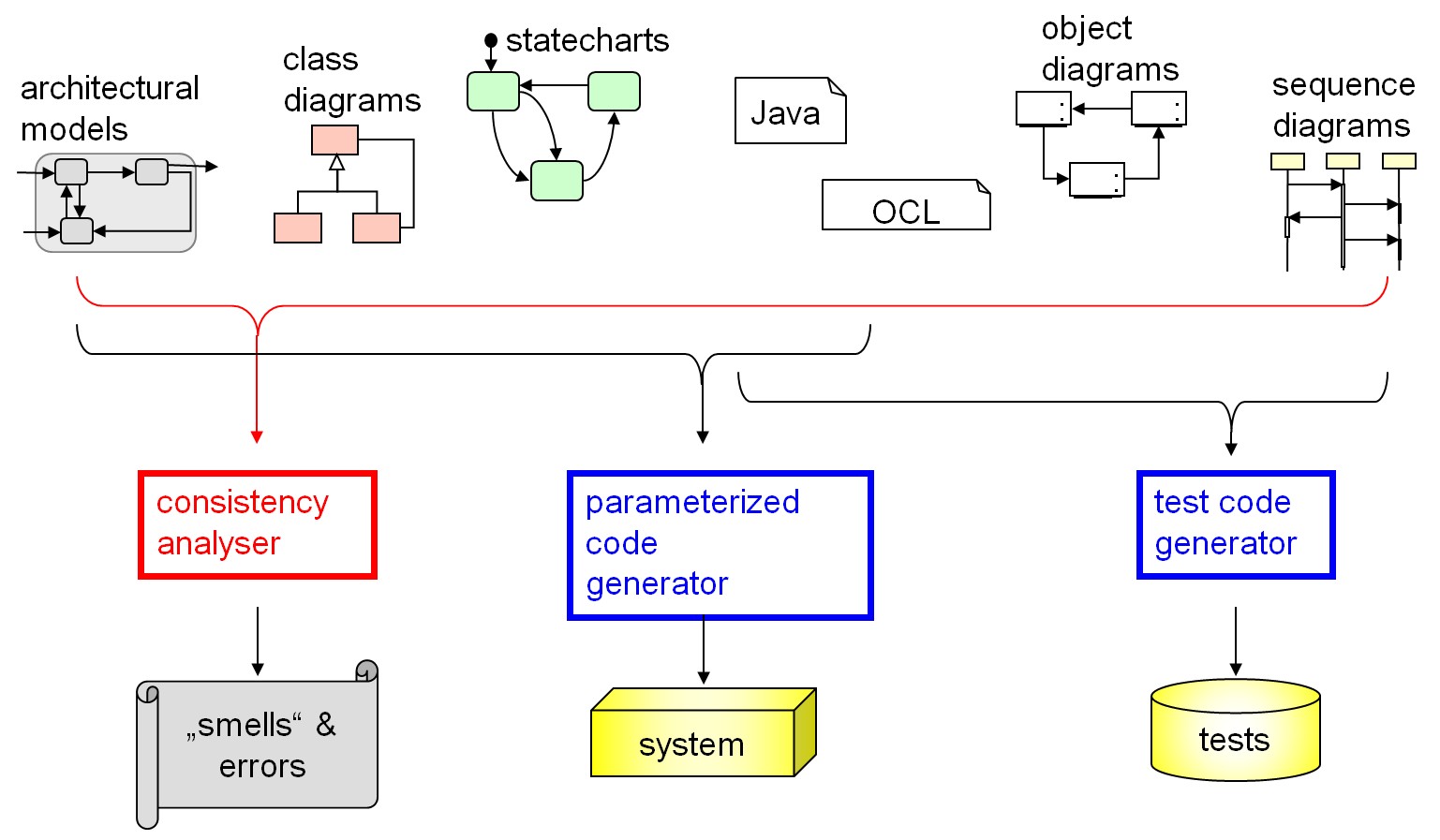UML/P
Summary of Most Relevant Topic Papers
The UML/P [Rum16] [Rum17] [Rum12] [Rum11] is a realization [Sch12] of a subset of the modeling languages of the UML with particular focus on applicability for programming, i.e., modeling of software systems (the “P” in UML/P stands for “suitable for programming”). It comprises the following types of UML diagrams:
- Class Diagrams as basic structural modeling technique with solid yet configurable semantics [MRR11f] [MRR11e],
- Object Diagrams to describe specific situations that are used for setups of tests or test verdicts as well as unwanted situations, etc. [MRR11c].
- Statecharts are the main technique to describe behavior. UML/P Statecharts can be used as abstract specifications, explicitly allowing underspecification in various forms as well as code-like detailed algorithms, where a direct mapping to code becomes feasible. UML/P Statecharts assist the large bandwidth between high-level abstract specifications and implementations and come with a powerful refinement calculus allowing for the refinement of specifications throughout the development process as well as from superclasses to specific implementations in subclasses.
- Sequence Diagrams describe interactions between objects in a specific situation and thus are generally exemplary. They can be used nicely for describing the set up and the execution of tests.
- OCL is a textual language in the spirit of predicate logic over object models, allowing to describe constraints of various forms. OCL/P is a specific variant of OCL that allows for writing constraints in a syntax inspired by Java [GJS05]. It is extended by various techniques for set and list comprehension known from functional languages like Haskell.
These languages can be used individually as well as in a coherent language family that allows to connect models of different sublanguages into a well structured, accessible specification of complex systems.
This constitutes a powerful way of describing software systems on various levels of abstraction from different viewpoints. In addition, it is possible to use Java expressions to enrich the models with implementation details. As such, UML/P forms the foundation for applied Generative Software Engineering.
To shape UML/P as a modular, composable set of languages, we have intensively applied the techniques of Software Language Engineering (SLE). As an example, OCL is not only a stand-alone constraint language, but it is also used for pre- and post-conditions in Statechart transitions, for state invariants, for desired properties to describe the verdict of tests, and for desired properties while inside a sequence diagram-governed test execution.
For the constructive part of UML/P Java expressions are also integrated in various UML/P sublanguages. This integration relies on solid foundations, actually allowing for intensive consistency checks within models of all sublanguages as indicated in the figure below. This includes type checking of variables introduced and used in sublanguages as well as the mapping of symbols defined in one sublanguage to another sublanguage.

Because object diagrams have limited expressiveness on their own, we have integrated object diagrams into OCL/P to identify specific scenarios via diagrams and connecting them with powerful logic operators of OCL/P. The integration of object diagrams into OCL/P allows for describing the context of invariants and specifying situations that are allowed, forbidden, or alternatives. This yields a powerful yet partially diagrammatic logic specification technique.
We also have dealt with activity diagrams [MRR11d] [MRR11a] as extension of the UML/P and the ADL MontiArc completes UML/P with a notation for logically or physically distributed computation [BKRW17a].
Parts of UML/P are available from the MontiCore Website as an Eclipse plugin featuring syntax-aware editors for the various types of diagrams. We have successfully applied UML/P for generatively creating various kinds of software systems. This spans from database schemas over web applications up to entire data management desktop applications. UML/P is under continuous extension with interesting new features.
Below we provide a selection of relevant publications about the UML/P as well as related interesting topics. Please also note the MontiCore Website for details on the technology as well as access to the UML/P itself.
![]()
Selected Topic-Specific Publications
-
[BKRW17a]In: In 12th International Conference on Software Engineering Advances (ICSEA 2017), pp. 213-218, IARIA XPS Press, May 2017.
-
[Rum17]Springer International, May 2017.
-
[Rum16]Springer International, Jul. 2016.
-
[Rum12]Springer Berlin, Jun. 2012.
-
[Sch12]Aachener Informatik-Berichte, Software Engineering, Band 11, ISBN 978-3-8440-0864-7, Shaker Verlag, 2012.
-
[Rum11]Springer Berlin, Sep. 2011.
-
[MRR11a]RWTH Aachen University, AIB-2011-07, Technical Report, Aachen, Germany, Jul. 2011.
-
[MRR11f]In: Conference on Model Driven Engineering Languages and Systems (MODELS’11), pp. 153-167, LNCS 6981, Springer, 2011.
-
[MRR11e]In: Conference on Model Driven Engineering Languages and Systems (MODELS’11), pp. 592-607, LNCS 6981, Springer, 2011.
-
[MRR11d]In: Conference on Foundations of Software Engineering (ESEC/FSE ’11), pp. 179-189, ACM, 2011.
-
[MRR11c]In: Object-Oriented Programming Conference (ECOOP’11), pp. 281-305, LNCS 6813, Springer, 2011.
-
[GJS05]Addison-Wesley, May 2005.
![]()
Related Topics
- Agile Model-Based Software Engineering
- Domain-Specific Languages (DSLs)
- Generative Software Engineering
- Software Language Engineering (SLE)
- MontiCore - Language Workbench
- Semantics of Modeling Languages
- Modeling Software Architecture
- State-Based Modeling (Automata)
- Unified Modeling Language (UML)
![]()